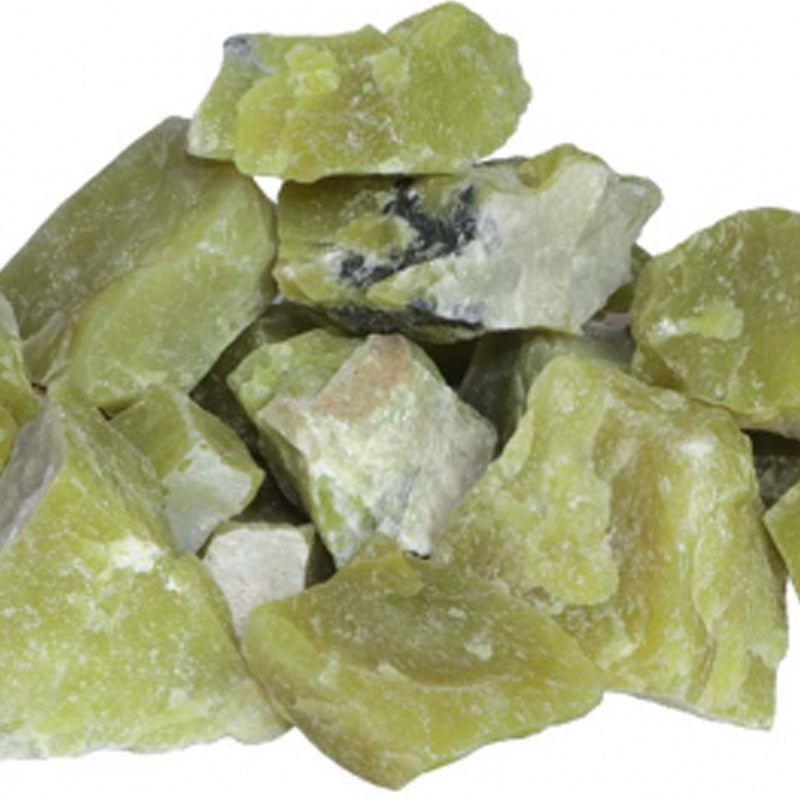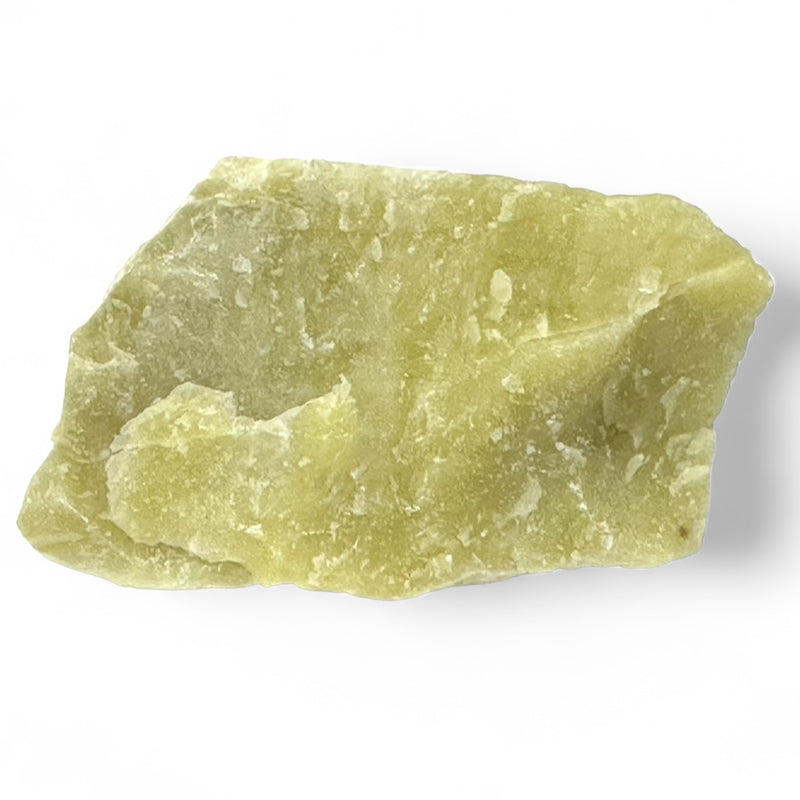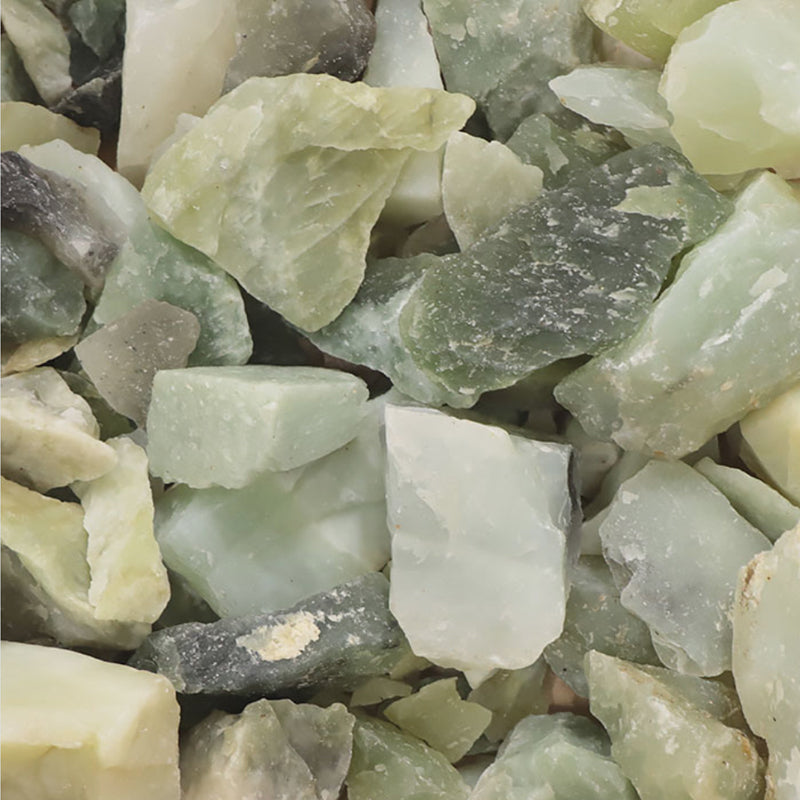Chinese Jade A (raw stone)
JADC-B-01
- Regular price
-
2,90€ - Regular price
-
- Sale price
-
2,90€
Couldn't load pickup availability
Learn more
JADC-B-01
Origin: China
Grade: A
Dimensions:
About 20-40mm
Weight:
Between 15 and 25g
Origin:
China
Grade:
A = good
Raw Chinese jade approximately 20-40mm
Sold individually.
Colors and shapes may vary from one stone to another
This magnificent stone, most often known by its green color, received its name from the conquistadors in the 15th century. They named it “piedra de ijada” or “stone for the pit”. The pit designating the iliac fossa due to Native American legends which said that jade treated the kidneys and renal colic. Furthermore, it was also attributed with the power to ward off evil spirits.
This stone with a hardness of between 6 and 7 on the Mohs scale, then depending on its variety is commonly used for the sculpture of ornamental objects or in jewelry. It turns out that under this name of jade there are three kinds of minerals. Their difference comes from their composition, however, they are very similar in appearance. These are jadeite, nephrite and kosmochlor.
In 1863, Alexis Damour, a French mineralogist, differentiated two mineral specimens under the name jade. He called the first “jadeite” and the second “nephrite” coming from the Latin “lapis Nephriticus” or “side stone” always in reference to the Native American legend. In 1897, the German mineralogist Hugo Laspeyre observed a third variety: kosmochlor, from the German “kosmischle” meaning “cosmic” and “Khlôr” designating the color green. In fact, this mineral comes from a meteorite that fell in Toluca, Mexico.
The main minerals constituting jade are therefore nephrite (composed of calcium and magnesium silicate) and jade jadeite (composed of sodium and aluminum silicate). Although jadeite is often associated with green, there are a large number of other colors including white, black, pink, blue-green, dark green, green-black, blue, emerald green, lavender , Orange-red. Completely pure jade is white; it is the presence of impurities or inclusions (titanium, manganese, chromium, iron) that give it these colors.
Nephrite jade ranges from creamy white to dark olive green, brown or black hues. It has a surface that appears to be covered with a light, smooth varnish. In China, jade has always been considered a precious stone, “the imperial stone”. The two minerals, jadeite and nephrite, making up jade have had different uses. Nephrite has been known and used in ancient China for millennia. On the other hand, a deposit of jadeite was exploited in Burma in 1800. From that moment, Burmese jadeite became the preferred form of imperial jade.
While in the West, diamonds, rubies and emeralds represented the precious stones worn by people of the nobility, in China, high-ranking individuals wore nephrite jade stones as a symbol of wealth.
Around 4,000 years ago, jade was used to make weapons, everyday objects such as (cups, plates, and even buttons), ornamental or ritual objects. The Egyptians gave jade as an offering to their goddess of justice, Maat. The Celts of Ireland represented their goddess of the feminine, Brigit in jade stone.
The Greeks linked jade to the Moire, who are the three goddesses of destiny, who accompanied men from their birth to their death. They used the healing properties of jade to treat the eyes, against snake bites, insect bites or against stomach aches.
For the Romans, jade was associated with the goddess of earth and fertility, Bona Dea.
But it is in China that jade has the most legends, symbols and medicinal uses. It represented the absolute power of the emperor. He had a jade scepter and each of his five princes had a jade tablet. Every year, a ceremony took place and the emperor took back the tablets. If he wanted to keep his princes, he returned the tablet to them. But he could also take them back and assign them to other princes. In Chinese mythology, jade symbolized dried dragon sperm. In the mouths of rich deceased people, a jade cicada was placed, thus preventing decomposition and promoting reincarnation.
The main deposits of jade are located in China.
Chinese jade is a stone of abundance that brings prosperity to its wearer. It facilitates openness towards others by promoting compassion, constructive exchanges and empathy. It thus generates understanding and acceptance of oneself and others.
Chinese jade fights against nervousness, stress, negative energies such as anxiety, worry and lack of self-confidence. It causes optimism and well-being. This stone breeds honesty and gives a sense of justice.
It is a stone which facilitates introspection and which allows us to understand certain buried guilts. Thus, it creates confidence and allows you to approach life with much fewer obstacles. It helps you refocus and listen to your inner voice. It is a stone that develops intuition.
Chinese jade soothes negative tensions and anger. When experiencing difficulties or misunderstandings with their child, they can encourage dialogue and communication in order to find a solution.
A stone of justice and morality, Chinese jade is often worn during negotiations, whether commercial or personal. It directs towards wisdom and legitimacy. It allows you to detach yourself from the judgment of others and to temper your comments. This stone gives the courage to face the difficulties of life with serenity and conviction.
Caractéristiques
Couleur :
- Green
Signe astrologique :
- Cancer
- Balance
Type de Pierre :
Âge :
Genre :




Chinese Jade A (raw stone)
- Regular price
-
2,90€ - Regular price
-
- Sale price
-
2,90€
Basé sur 2 avis soumis à un contrôle
- Pour plus d’informations sur les caractéristiques du contrôle des avis, la possibilité de contacter l’auteur de l’avis, les délais de publication et de conservation des avis, ainsi que les modalités de suppression ou modification des avis, merci de consulter nos CGU.
- Aucune contrepartie n’a été fournie en échange des avis, à l’exception des avis indiqués avec la mention "Récompensé et vérifié" et dont les modalités de contrôles sont disponibles ici.
- Les prénoms affichés avec un * ont été pseudonymisés à la demande de l'auteur.
-
2
-
0
-
0
-
0
-
0
Trier les avis
-
5/5VérifiéCollecté et vérifié par Avis Vérifiés
J'avais peur que la taille soit trop petite, mais elle est parfaite !
Cet avis vous a été utile ? Oui (0) Non(0)SignalerAvis du , suite à une expérience du par Audrey B.
Afficher les commentairesMasquer les commentaires -
5/5VérifiéCollecté et vérifié par Avis Vérifiés
Super site … colis bien emballé et détail de chaque article…
Cet avis vous a été utile ? Oui (0) Non(0)SignalerAvis du , suite à une expérience du par PHILIPPE P.
Afficher les commentairesMasquer les commentaires
- 1
-
100% SECURE PAYMENT
Paypal, credit card, check, transfer
-
FREE DELIVERY
from 40€ purchase
-
SATISFIED OR REFUNDED
14 days to change your mind
-
CUSTOMER SERVICE AVAILABLE
contact@laboiteacailloux.com
to receive all our offers, good deals and new products from La Boite à Cailloux





